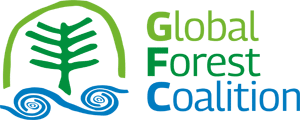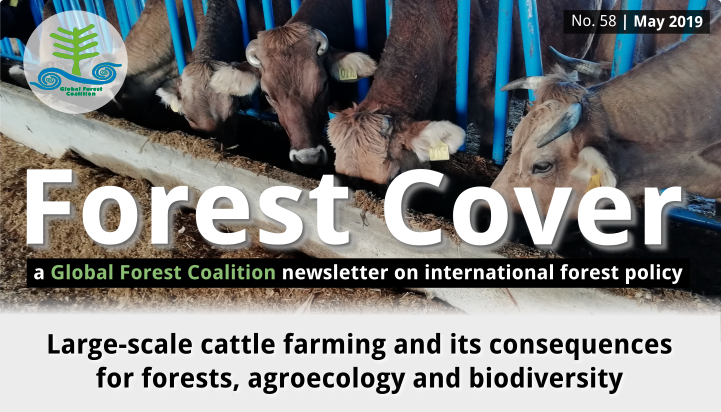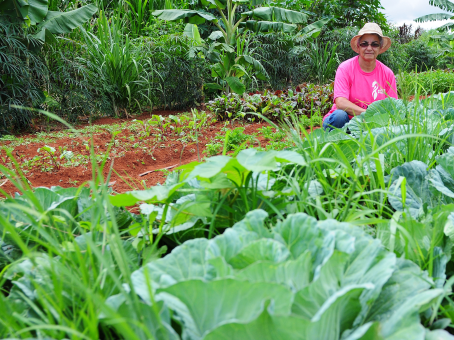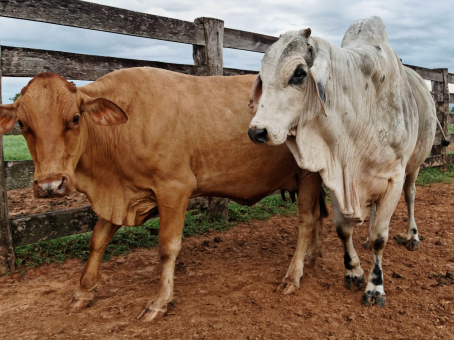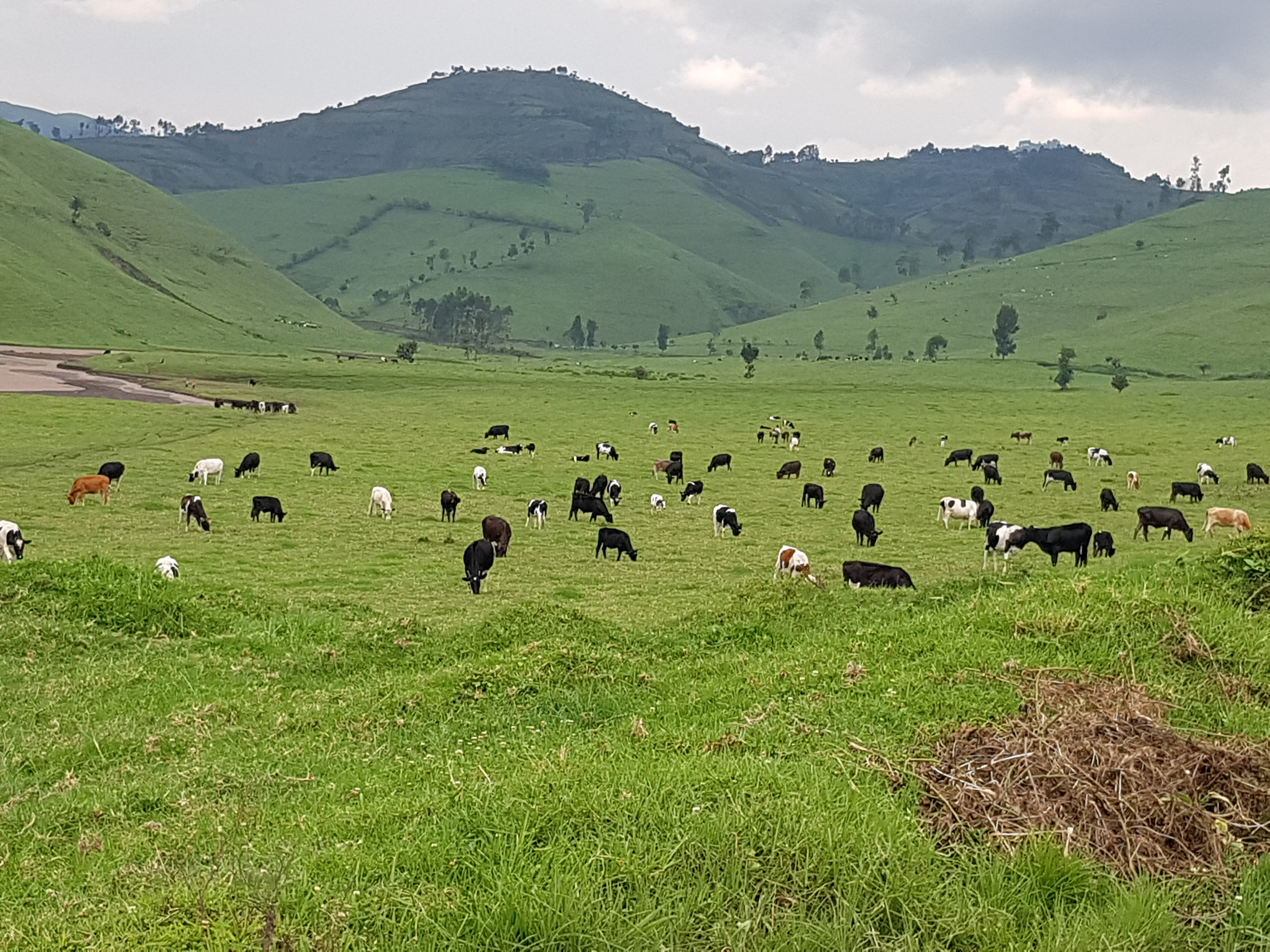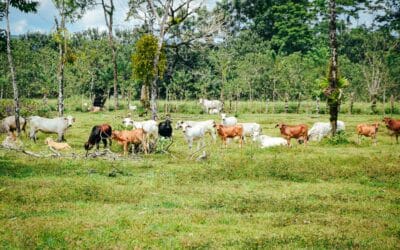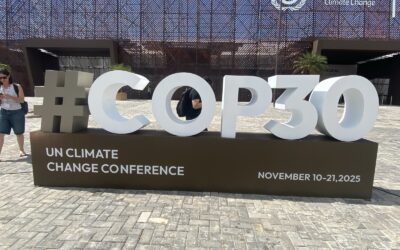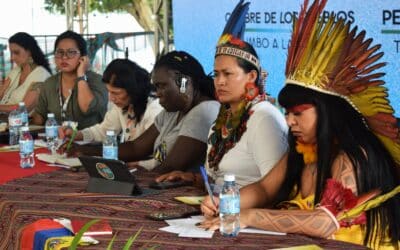The 58th issue of Forest Cover focuses on large-scale cattle farming and its incompatibility with other, more sustainable food systems and with thriving, healthy forests. Case studies from six countries describe the impacts of an industrial livestock industry that is hungry for land and resources, often highly polluting, and squeezing or stamping out other models of food production, such as traditional farming and agroecology.
Globally, the impacts of the international trade in beef make it the biggest culprit in deforestation, as forests and other ecosystems are cleared to make way for cattle pastures. Add to this the impacts of the industrial animal feedstock sector, which turns forests and other lands into vast expanses of monoculture genetically-modified crops to feed factory farmed animals (including cows), and the consequences of the industry as a whole are enormous.
The climate and biodiversity crises our planet faces desperately need practices like agroecology and small-scale, peasant farming to provide communities with food security and build climate resilience, and to protect and restore biodiverse ecosystems. But big agribusiness and in particular, large-scale livestock farming, is in direct conflict with these aims. It’s time for a transformation in global food production and consumption; the planet, its people, and other species require nothing less.
You can download the print version or read the articles individually below. You can also subscribe to our mailing list to receive Forest Cover and other publications.
Download the print version in English (web quality | low resolution) and Spanish (web quality | low resolution)
Contents:
Editorial: Time for a transformation in global food production
Industrial livestock farming in Brazil and its incompatibility with agroecological systems
Perfecting inequality: Industrial vs traditional livestock farming in Paraguay
Traditional and industrial livestock farming in Masisi, DRC: Between paradise and hell
Agrarian reform, counter-reform, and the contrast between agroecological systems and industrial cattle ranching in Chile
The ecological footprint of industrial cattle ranching in Mexico: The case of SuKarne
Cattle ranching on wetlands in Argentina: Doing the impossible
Editorial: Time for a transformation in global food production
By Isis Alvarez, Global Forest Coalition, Colombia
Cattle [1]—sacred in some parts of the world, and savoured in others—are the most common type of large domesticated animal globally. The global cattle herd is now one billion strong, [2] and the impacts of the industry that farms it are equally enormous in scale.
Beef is the worst internationally-traded commodity when it comes to deforestation and impacts on forests. For example, between 1990 and 2005, clearing forests to make way for cattle pasture was responsible for 71% of deforestation in seven Latin American countries, [3] home to vitally important and precious tropical forests. Beef and dairy production are also a leading cause of climate change, causing over 60% of the livestock sector’s total greenhouse gas emissions. [4] Up to half of Brazil’s greenhouse gas emissions are estimated to come from cattle (largely through clearing of forests and other vegetation for pastures). Extreme intensification is also making matters worse, as shown by the disaster caused by Hurricane Florence hitting “concentrated animal feed operations” in the southeastern United States, which left factory farms under water, thousands of animals dead and streams and rivers heavily polluted with the animals’ waste. [5]
This edition of Forest Cover looks at examples from six countries where forests and other important ecosystems are under threat from the industrial livestock model, and where local, small-scale, traditional and agroecological systems of food production are either being squeezed or stamped out by it. Case studies from Argentina, Brazil, Chile, Mexico and Paraguay highlight how big agribusiness is given free-reign over land and the lives of peasant farmers and Indigenous Peoples in Latin America because of the vast political support it receives. Meanwhile, a case study on North Kivu, Democratic Republic of the Congo, shows how imported models of large-scale cattle rearing conflict with traditional alternatives and cause deforestation of tropical forests in Africa.
Together, these case studies deconstruct the myth that large-scale, industrial agriculture is ‘feeding the world’, and that it is compatible with other more sustainable and equitable forms of food production. One model clearly comes at the expense of the other. Big agribusiness has captured international and national-level agricultural and trade policy-making, which continue to push this unsustainable agro-industrial model by providing incentives in the form of direct and indirect subsidies. [6] Cleaner forms of production, such as agroecological models and traditional peasant agriculture, lack appropriate forms and levels of support.
For instance, the Chile case study points to the fact that government support has prioritised large-scale, industrial agricultural production to such an extent that farms over 2,000 hectares in size now occupy 70% of agricultural land, and four companies produce more than 80% of Chile’s milk. Despite the expansion of large farms at the expense of smaller ones, the latter continue to produce more than half of the food consumed in the country. [7] However, the Chilean government is not acting to stop the disappearance of peasant agriculture. Among many other benefits, doing so would boost the potential for the empowerment of rural women, given that women’s livelihoods are closely linked to food production in peasant economies.
Paraguay has twice as many cows as people, and it is the world’s seventh-largest beef exporter. The Paraguayan Chaco region [8] has one of the highest rates of deforestation worldwide due to cattle ranching. In addition, serious human rights violations occur throughout the country, where indigenous and peasant communities are forced off their land and lose their livelihoods, while children suffer due to irresponsible spraying of agro-toxic pesticides over vast tracts of GM soy monocultures in the east of the country.
Recent scientific reports [9] clearly recognise the need for a deep transformation in our food systems, [10] given their huge impacts on human and planetary health. In fact, the latest Intergovernmental Panel on Climate Change report makes clear that in order to limit global temperature rises to 1.5°C, “a substantial reduction of [agriculture-related] impacts would only be possible with a substantial worldwide diet change, away from animal products”. [11]
It is hard to understand how, given the current environmental crises we are facing, most financial and political support for food production goes to a model that focuses on quantity rather than quality, and distributes the large quantity of food produced so unevenly that some parts of the world suffer from chronic hunger while others face a public health crisis due to obesity or over-nutrition. Further intensification of a model that ignores traditional livestock farming and agro-ecological systems, and in some cases puts them in direct conflict as highlighted in the case studies presented, will only mean continued deforestation, biodiversity loss, water scarcity, violations of human rights and animal welfare, and concentration of lands in the hands of the few, to the detriment of ancestral practices that have ensured food for local peoples for generations.
It is now time to promote a transformation that leads to food systems that value the health and well-being of animals, humans and the planet, that is not dictated by market forces and global commodity trade, that encourages biodiversity and cultural diversity, and where peasant farmers are free to save thousand-year-old seed varieties rather than being punished for doing so. Instead of a reckless model of production that promotes overconsumption and food waste and is dependent on synthetic inputs, we must strive for a just model based on traditional methods of production, ensuring balanced and sufficient diets for all, promoting rural autonomy and self-sufficiency, and allowing food producers to live healthy, safe and dignified lives.
[1] The term “cattle” throughout this publication refers to to both male and female cows, bread for beef and dairy, but not to buffalo, oxen, bison or any other large domesticated ruminants.
[2] https://www.statista.com/statistics/263979/global-cattle-population-since-1990/
[3] https://globalforestcoalition.org/whats-steak-real-cost-meat/
[4] https://www.theguardian.com/environment/2018/dec/05/beef-eating-must-fall-drastically-as-world-population-grows-report
[5] https://www.motherjones.com/food/2018/09/these-photos-of-submerged-north-carolina-livestock-farms-are-devastating/
[6] https://globalforestcoalition.org/perverse-incentives-deforestation-for-livestock/
[7] https://www.grain.org/article/entries/4929-hungry-for-land-small-farmers-feed-the-world-with-less-than-a-quarter-of-all-farmland
[8] The Chaco ecosystem also covers parts of Argentina, Brazil and Bolivia.
[9] See for example: https://eatforum.org/content/uploads/2019/04/EAT-Lancet_Commission_Summary_Report.pdf, https://report.ipcc.ch/sr15/pdf/sr15_spm_final.pdf, and https://wriorg.s3.amazonaws.com/s3fs-public/creating-sustainable-food-future_2.pdf?_ga=2.131141071.1387639736.1555603045-474768533.1555603045
[10] https://www.theguardian.com/environment/2018/dec/05/beef-eating-must-fall-drastically-as-world-population-grows-report
[11] https://www.theguardian.com/environment/2010/jun/02/un-report-meat-free-diet
Industrial livestock farming in Brazil and its incompatibility with agroecological systems
By Sílvio Isoppo Porto, consultant for Federação de Órgãos para Assistência Social e Educacional (FASE) and Diana Aguiar, FASE, Brazil
The introduction and expansion of livestock and cattle farming in Brazil largely came about with Portuguese colonial occupation in the first half of the 16th century, from the Atlantic Coast into the interior.
In the first few hundred years, cattle were used as traction animals and to meet the demand for animal protein and leather in the slave-holding societies linked to sugarcane and cotton plantations. Throughout the 17th and 18th centuries, cattle ranching began to move into the Caatinga, Cerrado, Pantanal and Pampa ecosystems in a slow process that involved the extermination of Indigenous Peoples and the expansion of the national frontier.
However, the dynamics of the expansion between the 18th century and the first decades of the 20th century were not homogenous. Some of the livestock rearing during this time involved traditional systems of production, and in many cases, it was done on common land. Knowledge gained through livestock management by traditional communities and peasant farmers allowed them to explore different agroecosystems, and to use and conserve biodiversity without causing major changes to the natural make-up of these systems.
It was in the 20th century, particularly from the 1940s to the 1960s, that livestock farming aggressively occupied the Cerrado (Brazil’s savannah), along with an accelerated increase in the size of cattle herds. It became the main economic activity that transformed the landscape through the removal of native vegetation to create vast pastures. The expansion of cattle rearing was also achieved through the violent appropriation of the lands of many Indigenous and traditional peoples, who were widely dispossessed of their traditional territories.
Cattle rearing in Brazil was boosted further in the 1970s, especially in the Central-West region, with the expansion of the country’s agricultural frontier and the implementation of the “Green Revolution” in agriculture, which was established by the military regime then in power. As part of this, the state subsidised a series of large-scale agricultural, livestock and infrastructure projects in Central Brazil to attract rural entrepreneurs from the South and Southeast of the country.
Since then, the increase in cattle numbers has occurred mainly through further deforestation to create new pasture and, to a lesser extent, through intensification. The construction of refrigerated meat packing facilities in the Central-West region supported this expansion and incentivised the industrial model. The use of planted pastures has also become increasingly common, especially with Brachiaria (signalgrass), which currently accounts for about 50% of the country’s total pasture. [1]
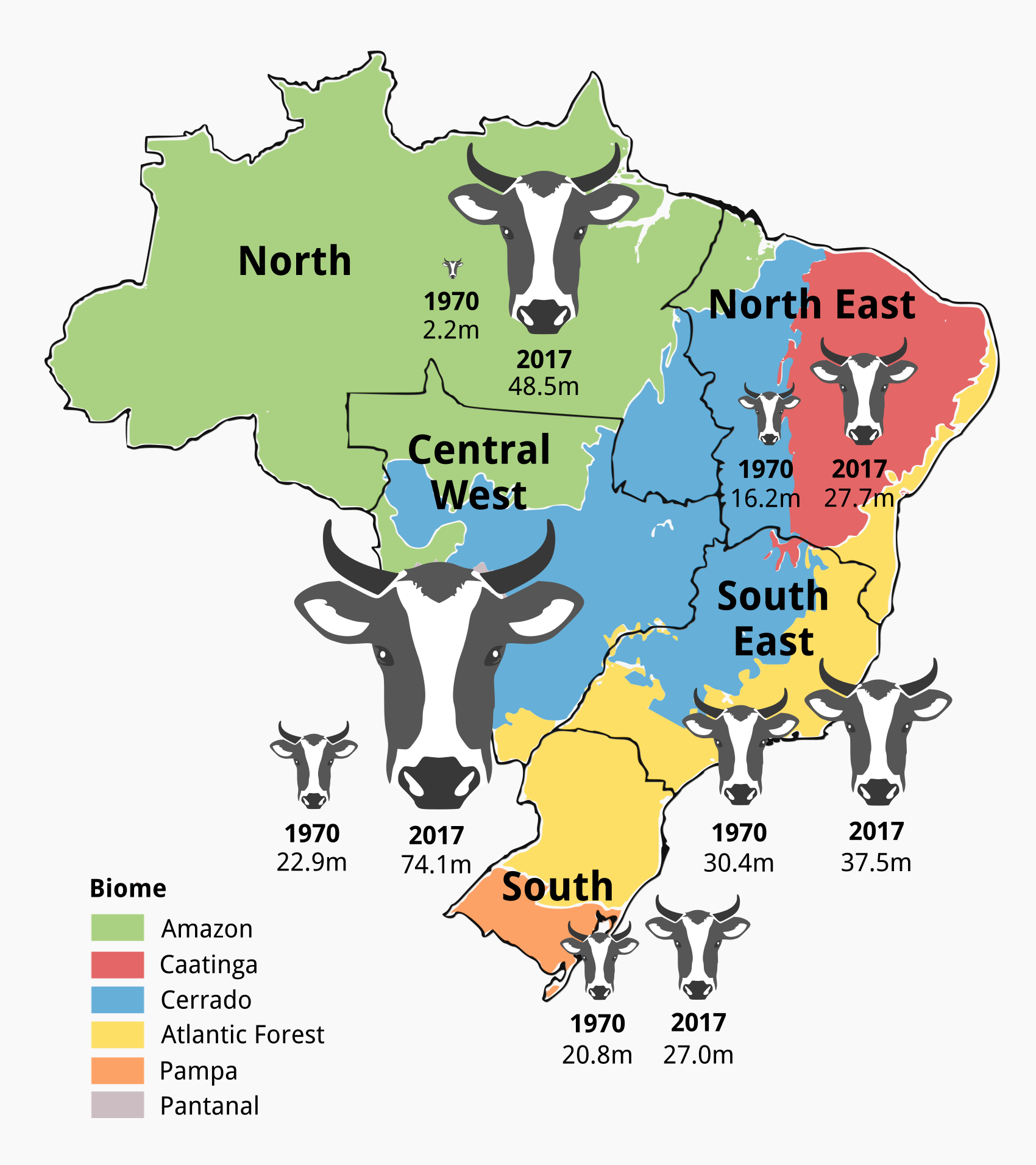
This diagram shows increasing herd size (in millions of cattle) between 1970 and 2017, for Brazil’s geographical regions, with types of Brazillian biomes superimposed. Herd sizes have increased most significantly in the North and Central West regions, corresponding to the Amazon and Cerrado biomes. Source: FASE
Brazil now has the second largest bovine herd in the world (about 226 million), [2] which is raised on approximately 160 million hectares of pasture. [3] It is also the world’s second largest meat producer (9.3 million tonnes/per year) [4] and largest exporter of beef (2 million tonnes/per year). [5]
Brazil’s industrial livestock farming model is incompatible with agroecological systems, as it is the largest driver of deforestation and biodiversity loss. This compromises the hydrological cycle and the retention of water in ecosystems, causing water stress and impacting microclimates, and therefore imposes limits on agroecological initiatives. Water is used highly intensively in the Brazilian livestock model, making conflict around access to and use of water inevitable. Land use change on the scale seen in Brazil compromises the flow of the humid Amazonian air masses to the Center-South region of the country. At the same time, the loss of native forests and disruption to hydrological cycles exacerbates the impacts of climate change.
As it expands, industrial livestock farming—together with soy and sugarcane monocultures—is also driving intense conflicts over land and territory, and transforming large areas into “food deserts”, where other forms of food production are displaced and the distances between sites of production and consumption are increased. It is a model that requires little labour and is directed towards commodity chains, while peasant economies, on the contrary, use family and community labour intensively, distribute wealth more evenly and involve many important social processes.
The expansion of livestock farming into the Cerrado, its margins and then into the Amazon is also directly related to land use change from cattle pastures to monocultures, especially soybeans. Since the 1980s and increasingly today, the expansion of the soy frontier from South to Central Brazil has continually shifted pastures North towards the Amazon, where pasture areas increased by more than 500% between 1985 and 2017, growing from 8.7 to 44.4 million hectares and causing the deforestation of 34.7 million hectares of land. In the Cerrado during the same period, 17.9 million hectares of native vegetation (forest and savanna) was converted to pasture, and 8.7 million hectares of pasture was in turn converted to annual or permanent crops, or to a mosaic of agriculture (i.e. involving soy monocultures and pasture). [6]
Brazil’s government recognised in 2009 that land use change, where native forests and grasslands are replaced by agricultural activities in the Amazon and Cerrado, accounted for most of the country’s carbon emissions. [7] Consequently, the Plan for Low Carbon Emission Agriculture (Plano ABC) was launched in 2010, with various commitments to reducing deforestation and restoring degraded pastures, to mitigate the impacts of livestock farming on climate change. However, the Plano ABC simply replicates the “Green Revolution” model and focuses on the intensive use of agricultural inputs (fertilizers and agrochemicals) and in particular livestock rearing destined for export, rather than addressing the completely unsustainable scale of the industry.
More recently, the political rise of conservative forces in Brazil is causing the dismantling of institutional frameworks and public policies achieved through the social struggles of traditional communities, family and peasant agriculture, and agroecological, socio-environmental, and indigenous movements. This is leading to, among other negative outcomes, the tearing-apart of the National Plan for Agroecology and Organic Production, as well as halting progress on agrarian reform and the demarcation of indigenous lands and
quilomba [8] territories.
At the same time, the current government is financially suffocating rural organisations, especially those that implemented public programmes, and has also indicated that it could frame social movements fighting for agrarian reform as terrorist organisations. In this context, industrial livestock farming and agribusiness in its most destructive forms finds itself in an environment of impunity, with nothing to hold back its desire for expansion while, on the other hand, agroecological systems are increasingly squeezed out by this model.
[1] https://ainfo.cnptia.embrapa.br/digital/bitstream/item/95462/1/Degradacao-pastagens-alternativas-recuperacao-M-Macedo-Scot.pdf
[2] Here bovine herd refers to cattle and other large ruminants such as buffalo: http://www.farmnews.com.br/mercado/produtores-de-carne-bovina/
[3] Censo Agropecuário 2017 (IBGE, 2018)
[4] Pesquisa Pecuária Municipal – PPM (IBGE, 2018) and http://www.farmnews.com.br/mercado/produtores-de-carne-bovina/
[5] http://www.farmnews.com.br/mercado/produtores-de-carne-bovina/
[6] Projeto MapBiomas – Coleção 3.1 da Série Anual de Mapas de Cobertura e Uso de Solo do Brasil, http://mapbiomas.org/map#transitions
[7] At COP15 in 2009, Brazil presented its voluntary guidelines, with targets for CO2 emission reductions, and recognised that land use change involving agriculture was responsible for most of Brazil’s emissions.
[8] Cultural term for the descendants of Afro-Brazilian slaves that escaped from slave plantations that existed in Brazil until abolition in 1888.
Perfecting inequality: Industrial vs traditional livestock farming in Paraguay
By Miguel Lovera, Iniciativa Amotocodie, and Inés Fransceschelli, Heñói, Paraguay
Paraguay currently has nearly 7 million people and 14 million head of cattle. Annually, the country slaughters 2.5 million cattle and exports 380,000 tonnes of meat, making it the world’s seventh largest beef exporter (the sector represents 12.1% of GDP). It has 17 processing plants for the amount produced, three of which handle nearly 70% of total exports: Frigorifico Concepcion, JBS, and Minervea foods—all of them Brazilian-owned.
Paraguay claims the world’s fastest increase in the production and export of beef, with more than a 17-fold growth in this industry in the last 10 years. A FAO-OECD study in June 2013 identified the country’s beef sector as having the greatest growth potential in the world over the next decade: 46% growth in production and 52% in exports, in comparison to the 1.6% annual growth projected for the global economy.
In contrast, Paraguay’s rural population maintains ancient productive practices that are in harmony with nature, with low-impact consumption patterns. The vast majority of peasant families have a few head of cattle on their farms and practice a form of cattle ranching that is adapted to the environment and visibly run by women. Women largely share ownership and management decisions in this system. They bring cattle to graze on communal fields each day, organise and remember the details of the lactation of each cow, take care of lactating animals, and produce other products from their cattle for family consumption or sale.
The animals generally have names and live on the family property, sheltered from the elements. This “other” cattle ranching endures despite the complete lack of public policies favouring it, and the absence of readily-available credit, agricultural insurance, technical assistance, training, year-round roads, or clear markets for selling to local areas.
Along with this lack of support for small-scale producers, the economic power of cattle ranching in Paraguay is extremely concentrated: 90% of ranchers own herds of less than 100 head of cattle, accounting for 18% of the national total, while 10% of ranchers (those with more than 100 head of cattle) own 82% of the country’s cattle. This concentration is more pronounced if we consider the “big ranchers” owning farms with more than 1,000 head of cattle. By this measure, 2% of ranchers own 54% of herds nationally.
This concentration mirrors the country’s high concentration of land: 2.6% of landowners possess 89% of all acreage dedicated to agribusiness, [1] a situation of near perfect inequality. It also goes hand-in-hand with the high concentration of land used for export agribusiness: 94% of the cultivated area is dedicated to export agribusiness, while 6% is used for domestic food production. This is similar to the inequality Paraguay experiences in terms of access to goods: poverty affects 29% of the country’s urban population and 35% of its rural population. [2]
These figures demonstrate consistently deep inequality and the fact that a handful of landowners and extractive industries have seized control of the national territory and the state, which has a major impact on the country’s population and ecosystems. Most of the expansion in cattle ranching has occurred in the Paraguayan Chaco, a semi-arid region of dry forests and tall, herbaceous savannahs. The Chaco is being deforested at a rate of 300,000 hectares per year, [3] which constitutes one of the principal obstacles to conservation and the resilience of the local population.
The state’s effective abandonment of peasant and indigenous populations is itself a public policy aimed at exterminating these communities from rural territories as a “nuisance” to make way for the further expansion of extractive capitalist industry.
In sum, Paraguay is essentially two countries. One is the Paraguay of agribusiness, in which feudal control exercised by large landowners both old and new—particularly established under the right wing regime that has ruled the country since 1954—is making rapid strides toward the neoliberal capitalist penetration that is jolting the Paraguayan economy. This process is controlled by foreign capital (North American and European for genetically-modified soybeans and corn and sanitary livestock inputs, Brazilian for the slaughtering and export of beef).
The main markers of this process are the incessant expansion of cattle ranches in the Paraguayan Chaco, with the consequent destruction of vegetation, and particularly exhaustive deforestation, this entails. Another outcome is the the consolidation of areas exclusively controlled by private owners, which impedes the state’s normal legal functioning.
The second country is Guaraní-speaking Paraguay, which conserves the labor practices of minga and jopoi [4] and relies on different trade and economic practices based on solidarity. In this country—that of resistance—each day there is less land, less capital, and the conditions for social, economic and environmental wellbeing worsen. Despite this, the country of resistance mobilised record numbers of people (around 40,000) in March 2019 to reclaim “Land and Production for National Development.”
Until limits are placed on the former Paraguay based on the principles of sustainability, the struggle by the latter Paraguay will not cease.
[1] The Gini Index for land ownership in Paraguay is 0.93.
[2] The Palma Index for Paraguay is 4.2.
[3] Lovera, M. 2014. The Environmental and Social Impacts of Unsustainable Livestock Farming and Soybean Production in Paraguay: A Case Study. Amsterdam: Global Forest Coalition
[4] Practices involving collective work in which neighbors, relatives, and friends get together to jointly carry out a task that, if done individually, would take much more time and effort. Once finished, the group does the same to benefit another member.
Traditional and industrial livestock farming in Masisi, DRC: Between paradise and hell
By Olive Imani, Council for the Land of the Ancestors (CTA), DRC
In general, two types of farming are practiced in Masisi territory, North Kivu, Eastern Democratic Republic of the Congo: traditional breeding and modern or industrial breeding. These days, modern breeding takes precedence over traditional breeding, which is endangered and increasingly being abandoned despite benefits to breeders and their cattle.
The expansion of livestock farming in the Masisi territory is due to large-scale breeding, with more than 700 pastures, most of which are used by Hutu and Tutsi communities with large herds. They have spread a modern breeding culture by importing cattle breeds for rapid animal production for milk, meat, manure and other purposes. Traditional breeding is generally practiced by the other ethnic groups, the Batembo and Bahunde, which represent only 30% of Masisi’s total population. The indigenous pygmies, the first inhabitants of this area, are victims of land-grabbing, and the lands they are expelled from are transformed into pasture. There have also been conflicts between peasant farmers, who are mostly Hundes and Tembos, and large breeders.
The increase in the number and size of farms and pastures has been the greatest cause of forest loss in Masisi territory, and 60% of the area has now been deforested. This has caused substantial changes to the ecology and climate of the region, with the loss of habitat resulting in a significant loss of species. Poor planning and land use management, coupled with unsustainable resource management, has degraded soils and put pressure on wood and timber resources. Conflicts have occurred over the use of land, and the insufficient arable space for other forms of agriculture. A reduction in overall agricultural productivity has had a negative impact on small-scale landowners, farmers, and fishing communities.
The continued loss of forests in the region is a major threat to biodiversity and the ability of the area to deal with the impacts of climate change and the disruption it brings. This is a huge loss for humanity. There is an urgent need to implement reforestation strategies by raising awareness of the environmental costs of destructive livestock farming practices among all stakeholders.
Conversely, practicing small-scale, traditional livestock farming has several benefits both for the environment and communities. Encouraging it would be an effective model for preventing conflicts between breeders and farmers, since it does not require large areas of land. It also has fewer impacts on biodiversity and forest loss and provides healthier food that requires no synthetic or chemical inputs, such as fertilizer.
This model is also far better for animals. Farmers that breed in a natural environment provide animals with incomparably better living conditions, meaning that they suffer far less than those in industrial production systems. However, regardless of the model of production, animals are still considered to be mechanisms of economic production, consumption and social capital, and the pursuit of profit is always to their detriment.
In Masisi, having livestock is a social asset and a source of prestige, as cattle are symbolic of wealth and worthy of respect in many peasant societies. Livestock can be important currency in dowry, inheritance and gift exchanges, which are often very complex, and can help to establish new herds and therefore livelihoods, symbolising the start of economic independence for small-scale farmers.
Cattle are therefore a source of power and are of great importance in social life, and the size of the herd often determines the political power of its owner. Marriage is also impossible without a certain number of cattle.
The traditional practice of breeding in Masisi is characterized, as in all of the indigenous and traditional societies of the Democratic Republic of Congo, by the bond between the cattle and the breeder. Having a herd of cattle places the farmer in a socially elevated setting which opens new horizons and means that other forms of income generation are not necessary.
The Council for the Land of the Ancestors (CTA, for its initials in French) is developing a new approach to restoring endangered traditional livestock rearing in the area through community-based field consultations and participatory planning meetings. In addition, CTA is proposing that communities be given access to training in agroecology practices and the application of agroforestry principles in order to restore degraded areas. Promoting traditional breeding instead of modern, large-scale techniques will help to sensitise and inform farmers about the consequences of large-scale deforestation and encourage the peaceful management of conflicts over land. It can also begin the process of reforesting and restoring degraded lands and farm areas and build community expertise in responsible agriculture.
The French sociologist and zoologist Jocelyne Porcher, who directs the National Institute of Agricultural Research (INRA-SAD) and whose research focuses on the working relationship between humans and animals, explains that traditional breeders have a much more humane relationship with their animals. They know them individually, and their central aim is not an obsessive maximisation of profit, so the animal is not reduced to a “commodity” that can be exploited mercilessly.
Agrarian reform, counter-reform, and the contrast between agroecological systems and industrial
livestock production in Chile
By Carolina Lagos, Colectivo VientoSur, Chile
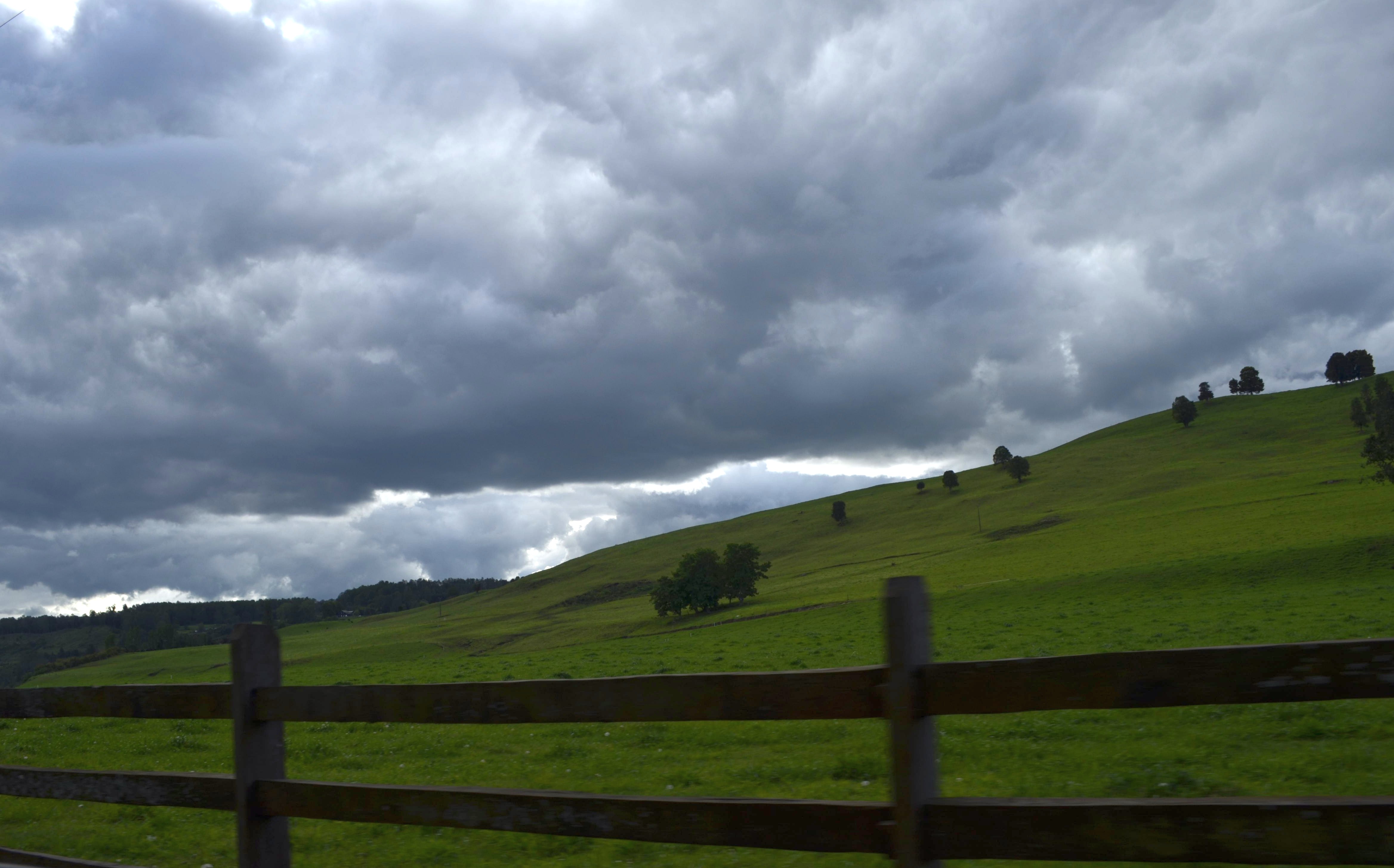
Industrial livestock farming requires large areas of land in Chile. This pasture is in Futrono, Los Ríos region. Carolina Lagos
In Chile in the 1960s, concerns over the concentration of land and its consequences in terms of reduced agricultural production and the exploitation and mistreatment of peasants led to the development of agrarian reform policies. [1] Agrarian reform was promoted by three consecutive government administrations and carried out between 1962 and 1973, and led to the exploitation of a greater number of smaller plots and contributed to the modernisation of the country’s agriculture. [2]
These reforms were reversed under the military dictatorship, a period (1973 to 1990) in which the decision was made to shift the administration of land to new capitalists in order to modernise production, once again strengthening the formation of large agrosilvopastoral enterprises. Permission to sell parcels distributed through land reform, among other legal measures implemented during the dictatorship that were unchanged under subsequent democratic administrations, facilitated a process of re-concentration of land ownership in subsequent decades. Census data and case studies demonstrate that the majority of larger properties expanded through purchases of land, both parcels from the agrarian reform and smaller fragments derived from this process. [3]
The main sectors that have benefitted from these counter-reform initiatives are forestry, agriculture, and livestock, all of which have grown due to the logging of native forests. [4] In the livestock sector, for example, a sharp concentration in land ownership occurred in the two decades between 1997 and 2007. Cattle pastures of over 2,000 hectares came to occupy 69.7% of the national surface area dedicated to livestock production. [5]
Meanwhile, the dairy sector includes 19,000 producers, of which only 2,500 are small producers. [6] Another notable aspect of this industry is the large concentration of powerful buyers, which has increased; currently, four leading companies buy 82.5% of milk from the major dairy companies. [7]
Why should we be concerned in Chile today about the concentration in ownership of productive land? Because it is not only the size of the plots that differentiates the large and small producers, but also the way in which they produce, as well as their impacts on the environment. For example, in the livestock industry, the large producers are highly specialised, and hence their farms tend to be exclusively dedicated to that sector, while small producers often engage in agricultural activities alongside production of livestock, poultry, and forestry.
On a small plot, all plant or animal waste is usually used as fertilizer and, as a result, is reincorporated into the productive cycle, returning to the soil many of the nutrients that are extracted through agricultural production. Meanwhile, traditional animal breeds are used that are less productive, but better adapted to environmental conditions, which means that they get sick less frequently and do not require antibiotics (or need less of them) or other inputs from outside the farm. Meanwhile, large producers, in their search to constantly increase production, use animal breeds brought from outside (usually from abroad), which results in animals that are less well adapted to the environment and require feed with a greater caloric and protein content.
This feed is also usually produced externally and is soy-based [8]—soy being a major cause of deforestation in the countries where it is grown, such as Brazil and Paraguay. Large industrial animal agriculture operations also require fertilizers, synthetic pesticides, antibiotics, and salts, among other external inputs.
Despite the expansion of large landholdings at the expense of small agricultural producers, [9] the latter have endured and indeed continue to produce more than half of the food consumed domestically in Chile. The situation is similar in nearly all countries in Latin America, as the GRAIN report for 2014 demonstrates. [10] Small farmers in Chile, particularly the beneficiaries of the Sustainable Agriculture Program of INDAP (the Agricultural Development Institute), [11] which encourages small producers to embrace agroecology as a production system, replace synthetic pesticides with biological pest control or the use of natural plant or mineral extracts. This leads to fewer impacts on human health and a smaller carbon footprint from transportation and air and water contamination.
Agroecological systems produce animal fodder on the farm, while large-scale production systems must transport feed produced off-farm, which can involve transport losses of up to 20% of the animal feed due to spoiling and other causes. Something similar occurs when products must be transported to consumer markets, which are generally far away from the productive centres of the large livestock industry. This often means the loss of a percentage of what is produced due to rotting en route. In contrast, agroecological producers often develop local networks of production and consumption.
In light of these data, and accepting the need to make progress on food sustainability to confront an environmental and food crisis that is global in nature, we must ask: why are governments in Latin America not working to halt the disappearance of peasant agriculture instead of promoting a concentrated production system that relies on increasing external resources, and has much greater ecological impacts in terms of carbon emissions, contamination, and energy consumption? In a world in which finding sustainable and rational production alternatives is urgent from a social and environmental perspective, drastic changes are needed in public policies regarding food production and distribution.
[1] Ortega, E. O. (1987). Transformaciones agrarias y campesinado: de la participación a la exclusión. CIEPLAN.
[2] Gómez Olivares, M. (2006). El estado de la agricultura chilena y sus transformaciones y modernización en Observatorio de la Economía Latinoamericana 62, June 2006. Available at: http://eumed.net/cursecon/ecolat/cl/
[3] Nilo, E. 2016. Distribución de la Ganadería Bovina de Carne y Ovina en Chile entre 1997 y 2007.Thesis in Veterinary Medicine. Universidad de Chile.
[4] Miranda, E., Altamirano, A., Cayuela, L., Lara, A., González, L., 2016. Native forest loss in the Chilean biodiversity hotspot: revealing the evidence. Regional Environmental Change. June 2016. Available at: http://www.forestal.uach.cl/manejador/resources/mirandaetal2016nativeforestlosschile.pdf
[5] Nilo, E. 2016. Distribución de la Ganadería Bovina de Carne y Ovina en Chile entre 1997 y 2007. Thesis in Veterinary Medicine. Universidad de Chile.
[6] ODEPA, 2017. Panorama de la agricultura chilena. Full text at: http://odepa.gob.cl/wp-content/uploads/2017/12/panoramaFinal20102017Web.pdf
[7] Ibid.
[8] Mera M, Baer E von, Hazard S (2000) Concentrados proteicos ¿Es posible sustituir importaciones? Agroanálisis 196: 33-36, December 2000. Available at: http://biblioteca.inia.cl/medios/carillanca/Descargas/Leguminosas/SustImProt.pdf
[9] 74.1% of agricultural landholdings are smaller than 20 hectares and their average surface area is less than five hectares.
[10] Grain, 2014. Hambrientos de tierra: los pueblos indígenas y campesinos alimentan al mundo con menos de un cuarto de la tierra agrícola mundial. Available at: https://www.grain.org/es/article/4956-hambrientos-de-tierra-los-pueblos-indigenas-y-campesinos-alimentan-al-mundo-con-menos-de-un-cuarto-de-la-tierra-agricola-mundial
[11] https://www.indap.gob.cl/agricultura-sustentable
The ecological footprint of industrial cattle ranching in Mexico: The case of SuKarne
By Irla Élida Vargas Del Ángel, José Alfredo Cruz Osorio, and Miguel Ángel Vargas Del Ángel, Mexico
Mexico’s beef exports have grown by 37% annually since 2004. [1] In 2017, national production of beef exceeded 1.9 million tonnes, while exports surpassed 194,000 tonnes. [2]
The beef industry in Mexico includes 23 meat packing plants. However, the boom in exports is explained primarily by the aggressive growth of SuKarne, a meat agribusiness, which processes one third of national production and sells 73% of Mexico’s beef exports. It does this through the creation of animal feeds based on oleaginous seeds (those which oils can be extracted from) and imported grains (each animal eats 1.6 tonnes of this feed over the 160 days that it spends in SuKarne feedlots, or 10 kg per day [3]), and the collection, fattening, slaughtering, processing and distribution of 1.3 million cattle per year, which yields 478 tonnes of beef. SuKarne has six business units in Mexico and one in Nicaragua. [4]
50% of land in Mexico is now given over to pasture and feedlots, where 32.9 million cattle graze and 2.5 million calves are fattened in some 54,000 corrals. Industrial cattle ranching has environmental impacts such as its carbon footprint [5], which ranges from 9 to 129 kg CO2eq per kg of beef produced by SuKarne [6]. Other negative consequences for the environment and biodiversity include soil erosion and degradation in pastures, the energy costs of the industry as a whole, the impact of wastewater from livestock operations on Mexico’s aquifers, and the substitution of forests with pastures and animal feed crops. [7] Every year, more than 155,000 hectares of forest is lost in Mexico, [8] in part due to the livestock and feedstock industries.
Regarding the hydrological footprint of the industry, SuKarne reports the consumption of 6.49 m3 of water per animal over the 160 days that each animal spends in its feedlots, [9] in addition to the use of blue and green water [10] for grain production (around 1,500 l/kg). Beef production also relies on the use and contamination of blue water for processes in industrial plants and for maintenance and dust mitigation, so that the average hydrological footprint for beef is estimated at 25,300 l/kg. [11]
Given the pressure on land and natural resources by calf production for this agribusiness model, farmers must abandon other types of production, such as milpa, an indigenous ancestral practice, which involves growing different species interspersed with each other (fruits, medicinal plants, maize, beans, pumpkins, sweet potatoes, and some herbs).
The environmental impacts of the packing houses are even more apparent. With regard to the Lucero plant in Durango state, in northwest Mexico, it has been reported that groundwater reserves have been depleted due to the extraction of this water to supply 300,000 calves being raised for veal. Domestic water supplied through the public network is now available at night only, because during the daytime, the water is monopolised by SuKarne. In 2015, the Mexican government provided a 1.5-million-peso subsidy to help build the plant, funds that could have been used to subsidise small-scale farmers [12] whose practices are more sustainable.
In Nuevo León state in the northeast of the country, residents of the city of Escobedo expelled a SuKarne plant with 60,000 calves, primarily due to environmental contamination (for example, dust, bad odours, and water runoff). [13] Another meat packing facility in Montemorelos, also in Nuevo León, caused the contamination of soils and nearby rivers (due to the use of antibiotics and chemicals), and damage to flora and fauna in the area even though the plant had a wastewater treatment plant. Environmental impact studies conducetd before the plant was built also did not consider these impacts. [14]
In the Alto Golfo de California Biosphere Reserve and the Colorado River Delta region, indigenous residents of Cucapá, located near the U.S. border, have expressed opposition to the implementation of the 14,000 hectare EcoZoneMex project. Waste from 300,000 head of cattle being raised there is to be reused for energy production without considering the impacts of the project on local populations of wild sheep, pumas, rattlesnakes, skunks, tarantulas, and more than 150 plant species. [15]
In Vistahermosa in the state of Michoacán, it has been impossible to mitigate the impacts from odours, dust, flies, wastewater discharge and runoff, soil contamination, and the generation of trash that the industrial livestock industry is responsible for there.
The combined impacts of greenhouse gas emissions, water usage and contamination, and impacts on forests and biodiversity from pollution and land clearance for pasture, mean that the ecological footprint of industrial cattle ranching in Mexico is enormous. Conversely, some agroecological models, such as the ancestral practice of milpa, are more respectful to the environment, make better use of natural resources, and promote the inclusion of women in the family economy.
Given the growth trends in the beef sector, all of the impacts it is responsible for are expected to worsen. To mitigate the impacts of this industry on climate change would require the intervention of the Mexican government to develop and implement suitable public policies to incentivise producers to adopt more sustainable and inclusive agroecological models of production such as milpa, and reject the industrial model of beef production exemplified by SuKarne and other large agribusinesses in Mexico.
[1] FIRA, 2017. Panorama agroalimentario, carne de bovino 2017. Dirección de investigación y evaluación económica y sectorial. México.
[2] AMEG, 2018. Estadísticas de la Asociación Mexicana de Engordadores de Ganado. Disponible en: http://www.ameg.org.mx/
[3] Quadratin 2015. Conoce SUMA procesos de la empresa Sukarne https://www.quadratin.com.mx/sucesos/Conoce-SUMA-procesos-la-empresa-Sukarne/
[4] SuKarne, 2018. http://sukarne.com/
[5] Rees, W. 1996. Revisiting Carrying Capacity: Area-Based Indicators of Sustainability. Population and Environment: A Journal of Interdisciplinary Studies Volume 17, Number 3, January. Human Sciences Press, Inc.
[6] Nijdam, D., Rood, T., Westhoek, H., 2012. The price of protein: a review of land use and carbon footprints from life cycle assessments of animal food products and their substitutes. Food Policy 37.
[7] Gerber, P.J. Steinfeld, H. Henderson, B. Mottet, A. Opio, C. Dijkman, J. Falcucci, A. & Tempio, G. 2013. Hacer frente al cambio climático a través de la ganadería – Evaluación global de las emisiones y las oportunidades de mitigación. Organización de las Naciones Unidas para la Alimentación y la Agricultura (FAO), Roma.
[8] Lira, I., 2017. La pérdida de bosques y selvas en México subio 36 % en 2016 por ago, turismo y minería. Sin embargo.
[9] Quadratin 2015. Conoce SUMA procesos de la empresa Sukarne https://www.quadratin.com.mx/sucesos/Conoce-SUMA-procesos-la-empresa-Sukarne/
[10] Green water is rainwater that falls onto pasture and is then absorbed by plants. Blue water is water from rivers, lakes and groundwater that also feeds pasture.
[11] Arreguin-Cortés F., López-Pérez M., Marengo-Magollón H. & Tejeda-González C. 2007. Agua virtual en México, Ingeniería Hidráulica en México. Vol XXII. No. 4, octubre – diciembre 2007.
[12] El demócrata 2017. Sukarne deja sin agua a la Laguna por alimentar a sus 300 mil vacas. 15 de mayo de 2017.
[13] Sistemas de innovación y desarrollo ambiental S.C. 2012. Manifestación de Impacto Ambiental Hidráulico, Modalidad Particular del Proyecto: “ptar y lagunas”. General Escobedo, Nuevo León, México.
[14] El economista 2011. Frenan en NL empacadora de carne. 31 de julio de 2011. Monterrey, México.
[15] Reporte índigo 2016. Un proyecto cuestionado. El proyecto EcoZoneMx promovido como “la nueva ciudad industrial verde de Baja California” avanza en Mexicali, pese a las protestas de organizaciones ambientalistas que apuntan a una devastación ecológica en la sierra Cucapah. Mexicali, septiembre 12 de 2016.
Cattle ranching on wetlands in Argentina: Doing the impossible
By Natalia Salvatico, Friends of the Earth, Argentina
The Paraná River flows through Brazil, Paraguay, Argentina and Uruguay. At 3,940 km in length, it is South America’s second longest river. It crosses six provinces in Argentina with vast floodplains, and in its last section, it divides into a series of branches, resulting in a set of islands (around 5,000) that make up the Paraná Delta. The Delta is in a constant state of growth, as the river deposits 500,000 tonnes of sediment annually. It currently covers a surface area of 17,500 km2.
This formation is the site of the ecological region of the Paraná Delta and Islands, considered an area of high priority for conservation as a region as a whole and specifically in terms of its coastal forests (called “Monte Blanco”), which include subtropical species characteristic of temperate grasslands, often constituting the southernmost area in which they are found. The islands of the Delta are characteristically bowl-shaped, with elevated edges called and a lower waterlogged, swampy interior.
Some decades ago, fruit production in the Delta was replaced by commercial willow production for making paper and fruit crates. This was initially accompanied by systems for protection against flooding which were connected to the waterways. Subsequently, in the 1990s, semi-closed or closed systems were implemented with the use of dykes, which increased the scale of tree plantations and cattle ranching. The silvopastoral system promoted for many years by forestry companies, [1] along with closed systems for water management, have a greater impact on the natural waterways, both structurally and functionally, than the open systems used previously.
Meanwhile, along with the expansion of soybean production, which is in a constant voracious search for new territory in Argentina, cattle ranching has also advanced along the rivers and flood zones in the Delta islands.
According to the Socio-Environmental Observatory on Soy, [2] the expansion of soybean cultivation through the use of the GMO/agrochemicals/direct planting technological package has resulted in a territorial reconfiguration of cattle ranching throughout the country. For example, much of the livestock in the Pampas were displaced to wetlands where the activity went from a seasonal, low-density system to a permanent, high-density one. This also involved the construction of more than 33,000 hectares of dikes and embankments and the obstruction of natural waterways to avoid flooding in the fields. Consequently, the hydrological system has been permanently altered. This situation led to a major increase in the number of livestock on the islands in the Delta, rising from 150,000 to 1.5 million between 1997 and 2007.
We interviewed Luis Cancelo, Director of the Permanent Advisory Council of the Islands and Martin Nunziata, an environmentalist and participant in the civil-society Assembly of the Delta and Rio de la Plata about the situation of cattle ranching in the Delta. “There are some parts of the Delta that have natural islets… where there are cows on a small scale. The islets are high, that is natural, they are this way because of their formation due to the circulation of the rivers,” Nunziata states.“Therefore, they are not an obstacle, as the dykes often are… The other thing is that the natural islets do not close off wetland areas, they do not produce that damage [caused by the artificial dykes].”
Arroyo Carabelas is one place where the silvopastoral experiment in the lower Delta has been carried out, but it is not the only one. Dykes are constructed far above the high water mark on which heavy machinery travels. When the dykes fail and the cattle are up to their necks in water, the ranchers request help from the state, which ends up providing emergency assistance. Here in the Delta, it is easy to see the links between the three rural productive systems with the greatest environmental impact: soy, forestry, and intensive cattle ranching, which also cause significant contamination through runoff into the river.
The use of glyphosate is well known in the region, including for unlikely things such as opening up roads or killing water hyacinth, a fast-growing aquatic plant. “When the water comes, it washes everything away. They have caused disasters,” Cancelo says.
“Cattle ranching in the Delta goes against the regional economies,” Cancelo and Nunziata conclude. “We want regional economies on a human scale, with value added, in the place where the resource is produced, so that the people who live there can have work.”
A form of production for the region without the use of dykes is being sought by the people of the islands (iseños/as). Historically, this was a fruit-producing zone. The islands also once produced timber on a medium scale. Reeds are the star crop, being native and used traditionally, along with willow and bamboo, which are exotic species that are also sold. Beekeeping is another activity that is flourishing in the Delta. Fish farming in small establishments and hydroponic plant nurseries are other options.
Tourism and sport fishing may currently be the biggest source of income in the area, but perhaps the Delta’s greatest attraction is the sense of melancholic romance it instills in visitors, many of whom return and defend it just like the islanders. The Delta is resisting the expansion of both forestry and cattle ranching, seeking its own way of functioning based on its own characteristics.
The “island way of life” involves living in stilt houses that coexist with the river, allowing the tide to rise, and understanding that floods are part of everyday life. It involves small- and medium-scale food production and fishing, which generate local economies that are in harmony with the biome, as well as navigating in small, slow-speed boats. It is a way of life that is as tranquil as a grassland river that, after it swells, always returns to its course.
[1] From May 14 to 16 of 2009, Posadas hosted the First National Congress of Silvopastoral Systems. The definition adopted by the organizers of the conference states: “Silvopastoral Systems (SPS) represent a mode of land use in which environmental, economic, and social interactions coexist among the trees, fodder, ranching, soils, environment, and human elements, based on sustainable management.”
[2] http://observatoriosoja.org/
Editorial Team: Coraina de la Plaza, Isis Alvarez, Mary Louise Malig, Mia MacDonald (Brighter Green), Oliver Munnion and Simone Lovera
Editors: Megan Morrissey and Oliver Munnion
Translators: Coraina de la Plaza, Danae Serinet Barrera, Megan Morrissey and Oliver Munnion
Graphic Design: Oliver Munnion
This Forest Cover was made possible through support from Misereor and the Swedish Society for Nature Conservation. The views expressed by our contributors are not necessarily the views of donors.
